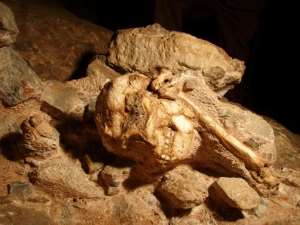
Paris (AFP) - New dating of South Africa's most famous hominid fossil confirms it is older than widely thought, boosting the country's claim to be a home of humankind, scientists said on Wednesday.
Named "Little Foot," the skeletal remains are those of a small ape-like creature who fell into a pit in South Africa's Sterkfontein cave complex millions of years ago.
How many years, though, is the question, and teams have put forward an extraordinary range of estimates, from 1.5 to four million.
The date is the key issue as to whether humans rose in East Africa, as a mainstream theory suggests, or in southern Africa -- or possibly in both or other places simultaneously.
The new dating of Little Foot, reported in the journal Nature, puts the remains at 3.67 million years old, give or take 160,000 years.
That makes it a rough contemporary of "Lucy," the Ethiopian hominid that has the most prominent claim on being our earliest-known ancestor.
"There is nothing to rule out the idea that (Little Foot) was the forerunner of humanity. Everything is possible," said Laurent Bruxelles from France's National Institute for Archaeological Research (Inrap), who took part in the study.
In the claim for being the cradle of humanity, "southern Africa is back in the race," Bruxelles said.
The evidence comes thanks to an updated form of the technology used to date the sediments in which the fossil was found.
The technique, called cosmogenic nuclide dating, looks at levels of rare isotopes that are created when soil or rocks are hit by high-speed particles that arrive from outer space.
A first attempt using this method, in 2003, suggested an age of four million years, although it had an enormous margin of error.
That estimate was dramatically countered by dating of different deposits, looking for uranium and lead isotopes, which gave a far younger age of 2.2 million years.
That was devastating news for Little Foot's champions, for it would relegate their fossil to a footnote in the human odyssey.
Last year, though, Bruxelles and colleagues determined that those calcite deposits had enveloped Little Foot in the cave at a much later date.
It would explain why the soil taken there was so much younger than the fossil itself. They deducted that Little Foot was "probably around three million" years old.
That work, in turn, led to a fresh dating of the sediments, using different search parameters and a powerful new instrument at Purdue University, Indiana, to measure two kinds of cosmogenic nuclides.
Out of 11 samples collected over a decade as the skeleton was teased from the sediment, the results from nine were in "stunning" alignment, "giving a robust age for the deposit," the University of the Witwatersrand said.
- Branches and forks -
Both Little Foot and Lucy are from a branch of the human family tree called Australopithecus.
This genus had both ape and human features and could walk upright.
That branch also has forks, with Little Foot called Australopithecus prometheus, and Lucy categorised as Australopithecus afarensis.
Their anatomies were "very different... (which) now raises interesting questions about early hominid diversity," said the study, led by Darryl Granger of Purdue University.
The Australopithecus hominids are thought to have given rise to Homo habilis, the direct ancestor to anatomically modern man, Homo sapiens.
The first traces of H. habilis are dated to around 2.5 million years ago.
Far older fossils of hominids have been unearthed in East Africa and Chad that pre-date both Lucy and Little Foot, but their lineage to Australopithecus is unknown.




 We’ll no longer tolerate your empty, unwarranted attacks – TUC blasts Prof Adei
We’ll no longer tolerate your empty, unwarranted attacks – TUC blasts Prof Adei
 Bawumia donates GHc200,000 to support Madina fire victims
Bawumia donates GHc200,000 to support Madina fire victims
 IMF to disburse US$360million third tranche to Ghana without creditors MoU
IMF to disburse US$360million third tranche to Ghana without creditors MoU
 Truck owner share insights into train collision incident
Truck owner share insights into train collision incident
 Paramount chief of Bassare Traditional Area passes on
Paramount chief of Bassare Traditional Area passes on
 Two teachers in court over alleged illegal possession of BECE papers
Two teachers in court over alleged illegal possession of BECE papers
 Sunyani: Victim allegedly shot by traditional warriors appeals for justice
Sunyani: Victim allegedly shot by traditional warriors appeals for justice
 Mahama vows to scrap teacher licensure exams, review Free SHS policy
Mahama vows to scrap teacher licensure exams, review Free SHS policy
 Government will replace burnt Madina shops with a new three-story, 120-store fac...
Government will replace burnt Madina shops with a new three-story, 120-store fac...
